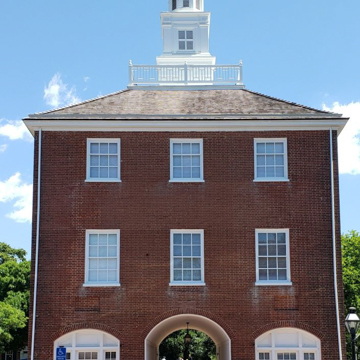England has many “head houses” like this one—town halls at the front of a series of market stalls—and one can still be seen in Philadelphia at New Market (c. 1805). The New Castle market stalls were entered through the big arch and once extended down the grassy median on Second Street; although demolished c. 1880, traces of their roofline are faintly visible today against the rear of Town Hall. The three-story brick hall—in basic form, about a forty-foot cube—housed the town council on the second floor. The cupola, with ball-and-sail weathervane, is one of Delaware's best (see the frontispiece on p. iv). The edifice now houses the zoning office, a newspaper, and the office of the Trustees of the Common. A renovation (Buck Simpers Architect + Associates) brought the building up to code so that town meetings could again take place inside. Behind stands a statue of William Penn (1984, Charles C. Parks).
You are here
Town Hall
If SAH Archipedia has been useful to you, please consider supporting it.
SAH Archipedia tells the story of the United States through its buildings, landscapes, and cities. This freely available resource empowers the public with authoritative knowledge that deepens their understanding and appreciation of the built environment. But the Society of Architectural Historians, which created SAH Archipedia with University of Virginia Press, needs your support to maintain the high-caliber research, writing, photography, cartography, editing, design, and programming that make SAH Archipedia a trusted online resource available to all who value the history of place, heritage tourism, and learning.






